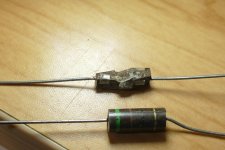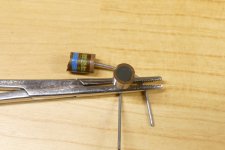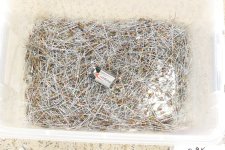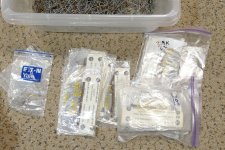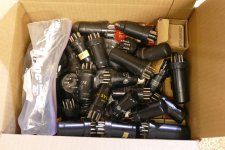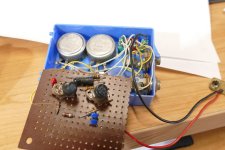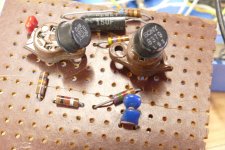Has anyone tried these ceramic composition ones?
In data sheets, haven't found info regarding the actual composition materials.
If carbon is used in their filler composition acting as conductive material, should they be essentially the same as carbon composition?
If there is surplus out there they sure do charge a premium.
At Mouser they charge 0.3-0.5 dollars per piece for what is left of Ohmite stock.
And the ceramic composition variety is even more expensive, more that a dollar per piece actually.
At ebay and elsewhere they charge up to a dollar per piece and for Allen Bradley it can go even higher.
So, folks if you have surplus of those - keep them!
Seems you'll be able to sell them in the future for a premium.
Anyway, since I am fond of the character of carbon composition resistors I'll keep looking for them but I am not willing to pay these exorbitant amounts.
Might as well go for vintage carbon-film military Soviet surplus for similar cost.
In data sheets, haven't found info regarding the actual composition materials.
If carbon is used in their filler composition acting as conductive material, should they be essentially the same as carbon composition?
If there is surplus out there they sure do charge a premium.
At Mouser they charge 0.3-0.5 dollars per piece for what is left of Ohmite stock.
And the ceramic composition variety is even more expensive, more that a dollar per piece actually.
At ebay and elsewhere they charge up to a dollar per piece and for Allen Bradley it can go even higher.
So, folks if you have surplus of those - keep them!
Seems you'll be able to sell them in the future for a premium.
Anyway, since I am fond of the character of carbon composition resistors I'll keep looking for them but I am not willing to pay these exorbitant amounts.
Might as well go for vintage carbon-film military Soviet surplus for similar cost.
Beware of FAKES!
I have seen resistors sold as "Carbon Comps" that contained a wirewound resistor, or even a leaded 1/4 watt carbon film resistor inside. Thin leads are often the give away.
If you are buying a bunch of surplus resistors, crush or cut one in half to see what's inside. The old style CCs will break pretty easily and something that looks like black pencil lead will be inside.
The fake in the first picture is a wirewound as can be clearly seen. This bad boy survived a hammer whack while sitting on a concrete block, so I chipped away at the case with sharp wire cutters.
The second resistor was labeled OHMITE 1.8 MEG 2 WATT right on the side and is genuine. It was easy to cut in half with the wirecutters.
I have seen resistors sold as "Carbon Comps" that contained a wirewound resistor, or even a leaded 1/4 watt carbon film resistor inside. Thin leads are often the give away.
If you are buying a bunch of surplus resistors, crush or cut one in half to see what's inside. The old style CCs will break pretty easily and something that looks like black pencil lead will be inside.
The fake in the first picture is a wirewound as can be clearly seen. This bad boy survived a hammer whack while sitting on a concrete block, so I chipped away at the case with sharp wire cutters.
The second resistor was labeled OHMITE 1.8 MEG 2 WATT right on the side and is genuine. It was easy to cut in half with the wirecutters.
Attachments
It surprise me that they would go all that way with the effort to masquerade them as carbon comp resistors.
So have anybody seen what's inside a ceramic composition resistor?
So have anybody seen what's inside a ceramic composition resistor?
The double width first band on a color coded resistor means it is a wirewound type.
Thanks Rayma. Mystery solved!From the horse's mouth:
https://www.ohmite.com/the-fundamentals-of-ceramic-composition-resistors/
So, ceramic composition resistors are essentially made of a carbon/ceramic composite.
I'm curious if they'll behave similarly to the classic carbon composite ones.
Will probably give them a try as an alternative, despite their higher price.
By the way, have anyone tried them?
OK, I never knew that. That explains the wirewound resistors. I have seen one that had what looks like an ordinary leaded metal or carbon film resistor inside. It was some time ago, so as with the two I cut open today, it was trashed long ago. I think that it came out of this bin full of resistors that I got at a hamfest long ago. I also have about 500 1K ohm 1/4 watt CC's, 700 6.2Ks and 400 3.9Ks all still in their Allen Bradley packaging. I have been using them on the grid of those high Gm TV IF amp tubes that like to oscillate and on the gates of some mosfets too. 9 volt battery thrown in for size comparison.The double width first band on a color coded resistor means it is a wirewound type.
Attachments
Maybe in the late 90's when the boutique
Guitar amp thing picked up.
There was the typical romance to old
magic parts.
Otherwise no reason to use them.
I have to say finding untouched old amps.
There is a unique cool factor to opening up
something with original parts.
Worthless usually, but otherwise fun to see
( and smell )
Got to say I like the idea of components looking
old but new parts hidden inside.
Make a new build look old.
Seeing old effect pedals with huge components
is comical and neat at the same time.
I used old surplus carbons for 9 volt fuzz pedals.
And liked to use metal can transistors.
Just to make simple circuits look interesting.
Didnt push any magic tone BS.
Often made fun of myself for making
them, but people enjoyed owning
something different and unique.
Guitar amp thing picked up.
There was the typical romance to old
magic parts.
Otherwise no reason to use them.
I have to say finding untouched old amps.
There is a unique cool factor to opening up
something with original parts.
Worthless usually, but otherwise fun to see
( and smell )
Got to say I like the idea of components looking
old but new parts hidden inside.
Make a new build look old.
Seeing old effect pedals with huge components
is comical and neat at the same time.
I used old surplus carbons for 9 volt fuzz pedals.
And liked to use metal can transistors.
Just to make simple circuits look interesting.
Didnt push any magic tone BS.
Often made fun of myself for making
them, but people enjoyed owning
something different and unique.
I just ordered a couple of ceramic composite to try then out.
These things are pricey!
By the way, i have done some tests with carbon composition versus carbon and metal films. Used the resistors in series with the signal and recorded the same music tracks.
I then used Audacity to perfectly match them in gain, edited the tracks to time-match them and played them back in foobar2000 using the ABX Test plugin. Used Sennheiser HD599 to audition them.
My auditory memory is very bad and i suffer from tinnitus but i could still hear some very small differences between them. Mainly in the way they affected sound image/stage and tone.
If i was not switching tracks on-the-fly and having them perfectly time-matched i am sure i'd never be able to identify any differences.
So basically, what i'm trying to say is that it's mainly a psychological thing to use vintage parts. Nostalgia and compulsion.
Also visual since to my eyes, vintage electronics look cooler than newer SMD stuff.
These things are pricey!
By the way, i have done some tests with carbon composition versus carbon and metal films. Used the resistors in series with the signal and recorded the same music tracks.
I then used Audacity to perfectly match them in gain, edited the tracks to time-match them and played them back in foobar2000 using the ABX Test plugin. Used Sennheiser HD599 to audition them.
My auditory memory is very bad and i suffer from tinnitus but i could still hear some very small differences between them. Mainly in the way they affected sound image/stage and tone.
If i was not switching tracks on-the-fly and having them perfectly time-matched i am sure i'd never be able to identify any differences.
So basically, what i'm trying to say is that it's mainly a psychological thing to use vintage parts. Nostalgia and compulsion.
Also visual since to my eyes, vintage electronics look cooler than newer SMD stuff.
Last edited:
The plastic bin full of "old looking resistors" came from a hamfest for $10 I think. I also have a bin full of old metal cased vacuum tubes that were hamfest scores. Many were free, but all cost less than $1 each. It includes 8 X metal 6V6s that are still shiny, and two metal 6L6s that are quite rusty. There is a mil spec 5T4 that's still new in the box for a rectifier.
Both collections are slated for a guitar amp build that I will call MetallicAmp, all tube, no glass. I still need some more "Bumble Bee caps" though. These are also prized "tone caps" in the eyes of some guitar and amp builders, and yes, there are fakes. My amp build will be a modern high gain screamer, but be constructed with all parts from before I was born (1952). That rules out the CK722 and 2N107.
Edit:
A quick web search for "bumblebee cap" reveals prices from $20 to $150 EACH! for an old leaky capacitor some of which are obviously well used. AES has new production bumble bee caps for $27 each. Guess I'm not going that route.
I remember seeing some "bumble bee reproductions" years ago that DID have a modern small cap inside, but I can't find them now. maybe people want to buy $30 tone caps, not cheap knock offs.
Both collections are slated for a guitar amp build that I will call MetallicAmp, all tube, no glass. I still need some more "Bumble Bee caps" though. These are also prized "tone caps" in the eyes of some guitar and amp builders, and yes, there are fakes. My amp build will be a modern high gain screamer, but be constructed with all parts from before I was born (1952). That rules out the CK722 and 2N107.
Edit:
A quick web search for "bumblebee cap" reveals prices from $20 to $150 EACH! for an old leaky capacitor some of which are obviously well used. AES has new production bumble bee caps for $27 each. Guess I'm not going that route.
I remember seeing some "bumble bee reproductions" years ago that DID have a modern small cap inside, but I can't find them now. maybe people want to buy $30 tone caps, not cheap knock offs.
Attachments
Last edited:
Faking a $2 resistor might not be so common, but faking a $50 capacitor is.
https://www.strat-talk.com/threads/bumblebee-caps-exposed.512322/
There is plenty of evidence that Gibson, and possibly Fender had their own fake bumble bees too.
https://www.strat-talk.com/threads/bumblebee-caps-exposed.512322/
There is plenty of evidence that Gibson, and possibly Fender had their own fake bumble bees too.
Totally agreed. There are some old parts that are just interesting looking making the electronics more a piece of art. Sometimes I mix NOS parts with my SMD-pcbs just for fun.Seeing old effect pedals with huge components
is comical and neat at the same time.
I used old surplus carbons for 9 volt fuzz pedals.
And liked to use metal can transistors.
Just to make simple circuits look interesting.
This is my first iteration of a germanium fuzz box that I made long before Al Gore invented the internet. Maybe even before the electric guitar was invented. 🙂
I got the schematic by taking a friend's Vox Tone Bender apart and tracing it's schematic.
The quality plastic box and phenolic proto board say "old junk" but the tantalum cap dates this contraption to about 1970. The funny looking transistors inside the Vox unit were unlike anything I ever saw, so I put sockets in this thing to test some transistors for best tone. The Sony parts came from some dead electronics, probably a radio. We all knew that CC resistors were the best.......since that's all we had in the 60's. They probably came from one of the local (Miami) surplus shops, or maybe the Lafayette Radio Electronics store. We didn't have a Radio Shack or Olson yet. The colorful ceramic caps did come from surplus shop known as the "Ham Shack" which became HS electronics, then went away. The transistor sockets with broken ears came from the dumpster behind Simpson Electronics, a manufacturer of HF marine radios.
I got the schematic by taking a friend's Vox Tone Bender apart and tracing it's schematic.
The quality plastic box and phenolic proto board say "old junk" but the tantalum cap dates this contraption to about 1970. The funny looking transistors inside the Vox unit were unlike anything I ever saw, so I put sockets in this thing to test some transistors for best tone. The Sony parts came from some dead electronics, probably a radio. We all knew that CC resistors were the best.......since that's all we had in the 60's. They probably came from one of the local (Miami) surplus shops, or maybe the Lafayette Radio Electronics store. We didn't have a Radio Shack or Olson yet. The colorful ceramic caps did come from surplus shop known as the "Ham Shack" which became HS electronics, then went away. The transistor sockets with broken ears came from the dumpster behind Simpson Electronics, a manufacturer of HF marine radios.
Attachments
Last edited:
They will sing the BLUES, will they...?It includes 8 X metal 6V6s that are still shiny
Regarding carbon composition resistors, I read that the resistive material is a mixture of ceramic with graphite powder.
Isn't that the exact same mixture used in the ceramic composition resistors?
And if so, what are the differences between those two (if indeed there are any)?
Isn't that the exact same mixture used in the ceramic composition resistors?
And if so, what are the differences between those two (if indeed there are any)?
I have often said that "EL84s were born to ROCK, but 6V6s must forever sing the blues." There is some truth to that statement due to the higher heater power in the EL84.They will sing the BLUES, will they...?
I will probably build the MetallicAmp because I have all the parts and I can, but I'm beginning to compile a list of all the features I would want in an "ultimate dream amp" kinda thing. I'll probably start a new thread for it once I have drooled over the literature for some of the multithousand dollar amps out there today.
Plenty of fun amps that have used little guys.
never cared for the things.
My buddy always said " Mini tubes? you mean the ones
that always died in TV sets.
LOL his pops was a 6V6 guy. No way around that.
Aint no rockin with dinky TV tubes
Im with yah though, take a large bottle 6V6 or 6L6 pair any day
Everyone has influences, so if your guy had a VOX
probably going like the little guys. We had a good run
in the studio. Some boutique amp with EL84
laid some tracks for sure.
Actually bet you anything it had carbon comps in it
LOL
never cared for the things.
My buddy always said " Mini tubes? you mean the ones
that always died in TV sets.
LOL his pops was a 6V6 guy. No way around that.
Aint no rockin with dinky TV tubes
Im with yah though, take a large bottle 6V6 or 6L6 pair any day
Everyone has influences, so if your guy had a VOX
probably going like the little guys. We had a good run
in the studio. Some boutique amp with EL84
laid some tracks for sure.
Actually bet you anything it had carbon comps in it
LOL
Last edited:
- Home
- Live Sound
- Instruments and Amps
- Carbon composition resistors
